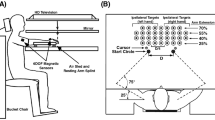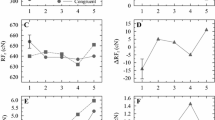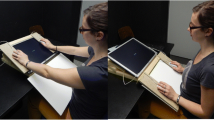Abstract
Asymmetries in hand movements have routinely been attributed to properties of the two cerebral hemispheres. In right-handed participants, the non-dominant left hand tends to have shorter reaction times, with the dominant right hand achieving shorter movement durations as well as higher peak velocities. The root cause of the surprising left hand RT effect has been debated, largely in the context of right hemisphere specialisation in attention, visuospatial abilities, or “premotor” processes. Mieschke et al. (Brain Cognit 45:1, 2001) and Barthélémy and Boulinguez ( Behav Brain Res 133:1, 2002) both tried to dissociate “premotor” processes explaining the left hand RT advantage, using reaching paradigms where at least one condition required target detection, but no visually guided aiming movement. Unfortunately, the studies obtained conflicting results and conclusions. In the present study, we attempted to re-examine this kind of paradigm with methodological improvements, such as using a task with higher visuospatial demands. Our results demonstrate that whilst RTs are longer as movement complexity increases across three conditions, the left hand RT advantage is present across all conditions—and no significant interaction between hand and condition was found. No significant hand differences were found in peak velocity or duration. These results suggest that the left hand RT advantage cannot be due to movement planning advantages of the right hemisphere, and instead should be attributed to sustained attention/vigilance lateralisation to the right cerebral hemisphere.




Similar content being viewed by others
References
Adam JJ, Nieuwenstein JH, Huys R, Paas FG, Kingma H, Willems P, Werry M (2000) Control of rapid aimed hand movements: the one-target advantage. J Exp Psychol Hum 26(1):295–312. doi:10.1037/0096-1523.26.1.295
Annett J, Annett M, Hudson PTW, Turner (1979) The control of movement in the preferred and non-preferred hands. Q J Exp Psychol 31(4):641–652. doi:10.1080/14640747908400755
Bakeman R (2005) Recommended effect size statistics for repeated measures designs. Behav Res Method 37(3):379–384. doi:10.3758/BF03192707
Barthélémy S, Boulinguez P (2002) Orienting visuospatial attention generates manual reaction time asymmetries in target detection and pointing. Behav Brain Res 133(1):109–116. doi:10.1016/S0166-4328(01)00446-6
Bekkering H, Pratt J (2004) Object-based processes in the planning of goal-directed hand movements. Q J Exp Psychol 57(8):1345–1368. doi:10.1080/02724980343000765
Bernard JA, Taylor SF, Seidler RD (2011) Handedness, dexterity, and motor cortical representations. J Neurophysiol 105(1):88–99. doi:10.1152/jn.00512.2010
Binder JR, Rao SM, Hammeke TA, Frost JA, Bandettini PA, Jesmanowicz A, Hyde JS (1995) Lateralized human brain language systems demonstrated by task subtraction functional magnetic resonance imaging. Arch Neurol 52(6):593–601. doi:10.1001/archneur.1995.00540300067015
Boulinguez P, Nougier V, Velay JL (2001a) Manual asymmetries in reaching movement control. I: study of right-handers. Cortex 37(1):101–122. doi:10.1016/S0010-9452(08)70561-6
Boulinguez P, Nougier V, Velay JL (2001b) Manual asymmetries in reaching movement control. II: study of left-handers. Cortex 37(1):123–138. doi:10.1016/S0010-9452(08)70562-8
Carey DP, Johnstone LT (2014) Quantifying cerebral asymmetries for language in dextrals and adextrals with random-effects meta analysis. Front Psychol 5:1128. doi:10.3389/fpsyg.2014.01128
Carey DP, Liddle J (2013) Hemifield or hemispace: what accounts for the ipsilateral advantages in visually-guided aiming? Exp Brain Res 230:323–331. doi:10.1007/s00221-013-3734-7
Carey DP, Hargreaves EL, Goodale MA (1996) Reaching to ipsilateral or contralateral targets: within-hemisphere visuomotor processing cannot explain hemispatial differences in motor control. Exp Brain Res 112:496–504. doi:10.1007/BF00227955
Carey DP, Sahraie A, Trevethan CT, Weiskrantz L (2008) Does localisation blindsight extend to two-dimensional targets? Neuropsychologia 46:3053–3060. doi:10.1016/j.neuropsychologia.2008.06.015
Carey DP, Otto-de Haart EG, Buckingham G, Dijkerman HC, Hargreaves EL, Goodale MA (2015) Are there right hemisphere contributions to visually-guided movement? Manipulating left hand reaction time advantages in dextrals. Front Psychol 6:1203. doi:10.3389/fpsyg.2015.01203
Carson RG (1993) Manual asymmetries: old problems and new directions. Hum Mov Sci 12(5):479–506. doi:10.1016/0167-9457(93)90001-6
Carson RG (1996) Putative right hemisphere contributions to the preparation of reaching and aiming movements. Hand preference and performance in skilled and unskilled activities. In: Elliot D, Roy EA (eds) Manual asymmetries in motor performance. FL, Boca Raton, pp 159–172
Carson RG, Chua R, Elliott D, Goodman D (1990a) The contribution of vision to asymmetries in manual aiming. Neuropsychologia 28(11):1215–1220. doi:10.1016/0028-3932(90)90056-T
Carson RG, Elliott D, Goodman D, Dickinson J (1990b) Manual asymmetries in the reproduction of a 3-dimensional spatial location. Neuropsychologia 28:99–103. doi:10.1016/0028-3932(90)90090-B
Carson RG, Goodman D, Chua R, Elliot D (1993) Asymmetries in the regulation of visually guided aiming. J Mot Behav 25:21–32. doi:10.1080/00222895.1993.9941636
Carson RG, Chua R, Goodman D, Byblow WD, Elliott D (1995) The preparation of aiming movements. Brain Cognit 28(2):133–154. doi:10.1006/brcg.1995.1161
Corballis MC (1997) The genetics and evolution of handedness. Psychol Rev 104:714–727. doi:10.1037/0033-295X.104.4.714
Cumming G (2012) Understanding the new statistics: effect sizes, confidence intervals, and meta-analysis. Routledge: Hove, East Sussex, UK
Danckert J, Rossetti Y (2005) Blindsight in action: what can the different sub-types of blindsight tell us about the control of visually guided actions? Neurosci Biobehav Rev 29(7):1035–1046. doi:10.1016/j.neubiorev.2005.02.001
DeRenzi E (1982) Disorders of space exploration and cognition. John Wiley, NY
Elliott D, Roy EA, Goodman D, Carson RG, Chua R, Maraj BKV (1993) Asymmetries in the preparation and control of manual aiming movements. Can J Exp Psychol 47:570–589. doi:10.1037/h0078856
Fisk JD, Goodale MA (1989) The effects of instructions to subjects on the programming of visually directed reaching movements. J Mot Behav 21(1):5–19. doi:10.1080/00222895.1989.10735461
Goble DJ, Brown SH (2008) The biological and behavioral basis of upper limb asymmetries in sensorimotor performance. Neurosci Biobehav Rev 32(3):598–610. doi:10.1016/j.neubiorev.2007.10.006
Heller W, Levy J (1981) Perception and expression of emotion in right-handers and left-handers. Neuropsychologia 19:263–272. doi:10.1016/0028-3932(81)90110-X
Jonikaitis D, Schubert T, Deubel H (2010) Preparing coordinated eye and hand movements: dual-task costs are not attentional. J Vis 10(14):23. doi:10.1167/10.14.23
Josse G, Tzourio-Mazoyer N (2004) Hemispheric specialization for language. Brain Res Rev 44(1):1–12. doi:10.1016/j.brainresrev.2003.10.001
Khan MA, Franks IM, Goodman D (1998) The effect of practice on the control of rapid aiming movements: evidence for an interdependency between programming and feedback processing. Q J Exp Psychol 51(2):425–443. doi:10.1080/713755756
Lakens D (2013) Calculating and reporting effect sizes to facilitate cumulative science: a practical primer for t-tests and ANOVAs. Front Psychol 4:863. doi:10.3389/fpsyg.2013.00863
Long H, Ma-Wyatt A (2014) The distribution of spatial attention changes with task demands during goal-directed reaching. Exp Brain Res 232(6):1883–1893. doi:10.1007/s00221-014-3880-6
McFie J, Piercy M, Zangwill OL (1950) Visual-spatial agnosia associated with lesions of the right cerebral hemisphere. Brain 73:167–190. doi:10.1093/brain/73.2.167
Mieschke PE, Elliott D, Helsen WF, Carson RG, Coull JA (2001) Manual asymmetries in the preparation and control of goal-directed movements. Brain Cognit 45(1):129–140. doi:10.1006/brcg.2000.1262
Posner MI, Peterson SE (1990) The attention system of the human brain. Ann Rev Neurosci 13:25–42. doi:10.1146/annurev.ne.13.030190.000325
Sainburg RL (2014) Convergent models of handedness and brain lateralization. Front Psychol 5(1092):1–14. doi:10.3389/fpsyg.2014.01092
Shapiro SS, Wilk MB (1965) An analysis of variance test for normality (complete samples). Biometrika 52(3/4):591–611. doi:10.2307/2333709
Steenhuis RE, Bryden MP (1989) Different dimensions of hand preference that relate to skilled and unskilled activities. Cortex 25:289–304. doi:10.1016/S0010-9452(89)80044-9
Todor JI, Cisneros J (1985) Accommodation to increased accuracy demands by the right and left hands. J Mot Behav 10:295–300. doi:10.1080/00222895.1985.10735354
Todor JI, Kyprie PM (1980) Hand differences in the rate and variability of rapid tapping. J Mot Behav 12(1):57–62. doi:10.1080/00222895.1980.10735205
Treisman A, Gormican S (1988) Feature analysis in early vision: evidence from search asymmetries. Psychol Rev 95(1):15–48. doi:10.1037/0033-295X.95.1.15
Acknowledgments
We are grateful to Bradley Dixon, Liz McManus, Lyam Sinar, and Arthur Norman for assistance with data collection. Llewellyn Morris, David Robinson, and David McKiernan provided expert technical assistance. This research was supported by Bangor University.
Author information
Authors and Affiliations
Corresponding author
Electronic supplementary material
Below is the link to the electronic supplementary material.
Rights and permissions
About this article
Cite this article
Johnstone, L.T., Carey, D.P. Do left hand reaction time advantages depend on localising unpredictable targets?. Exp Brain Res 234, 3625–3632 (2016). https://doi.org/10.1007/s00221-016-4758-6
Received:
Accepted:
Published:
Issue Date:
DOI: https://doi.org/10.1007/s00221-016-4758-6




